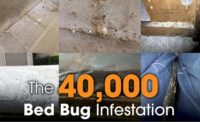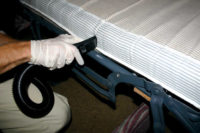Bed bugs are a hot topic. You can’t open a newspaper, watch a newscast or surf the web without seeing something about bed bug infestations. From five star hotels to timeshares, apartments, college campuses, military and oil field housing, you hear about bed bugs.
Bed Bug Fast FactsTop Infested Areas: • Apartments & Condos • Single Family Homes • Hotels & Motels 99.6% of pest control professionals dealt w/bed bugs in the last year 20% of Americas have been infested or know someone who has Bed bugs have been reported in all 50 states Summer has highest rate of infestation Source: National Pest Management Assoc. |
Bed bugs have been a universal pest for hundreds of years. The cleanliness stigma associated with them has been proven unfounded; a cluttered or dirty environment does not cause infestations although it can complicate the efforts needed to eradicate them. With world travel as routine as it is today, people can hop around the globe with greater frequency and these “tag along” insects are more than happy to hitch a ride. They know no class or gender, age or affluence… we are food to them. Simply put, they feed off human blood and typically the best “feed zones” are beds and any furniture where people reside for extended periods of time.
The resurgence of bed bugs has several contributing factors:
- A general increase in bed bug activity
- More frequent encounters during international travel
- Changes in pest management practices
- Resistance to pesticides
- Lack of public awareness on spreading bed bugs
A History of Infestation
Bed bugs were a common problem in the United States up through the World War II era. Around this time, they were virtually eradicated from the US with the accepted use of pesticides, such as DDT. During the late 1990’s, the bugs began to re-emerge as a pest in a number of countries. The majority of the infestations were identified in hotel guest rooms.
Changes in pest management practices and the development of resistance to modern day pesticides contributed to the proliferation of bed bug populations in the United States. In the past, guest rooms were typically treated on a routine basis with residual pesticides. However, during the mid-1990’s, the routinely scheduled treatments of baseboards in hotels, motels, and apartments were replaced with targeted applications of baits for pests such as ants and cockroaches. With the absence of residual pesticide applications, bed bugs could easily travel from luggage to the bed, chair or sofa and successfully begin an infestation.
Bed bugs are excellent hitchhikers and once introduced are able to spread to new locations quickly. Just spend one night in a bed bug infested environment and there is a good chance you will take them with you to your next destination. Some of the more common dispersal mechanisms include overnight stays in infested quarters, the purchase of infested furniture, the acquisition of discarded items that are infested, and migration of bed bugs from one infested dwelling to another in multi-occupancy settings (apartments, college housing, medical facilities, senior communities etc.)
Perhaps the most significant factor that has enabled bed bugs to spread is the lack of public awareness. Many people simply do not realize bed bugs truly exist. They don’t think twice about picking up discarded furniture that may be infested and bringing it into their home. Once the bugs are introduced, it is not uncommon for infestations to go undetected for several months or more. Infestations are not detected sooner due to the secretive habits of bed bugs. They are typically active at night, coming out to feed on people as they sleep. Their bite is painless so people are unaware that they have been bitten. Upon finishing their blood meal, they return to their harborages where they remain undetected and are not likely to come out until it is time to feed again (often going several days to a week or more between meals). Many people must first become sensitized to the bite before developing any bite symptoms, while others never react. It is not uncommon for people to have delayed reactions of several weeks or more. If symptoms do occur, they are often confused with poison ivy, scabies, allergic reactions, etc. All of these factors enable bed bugs to become well established before the occupants can identify the cause. Determining the location where one was actually bitten when travelling is difficult at best.
Keys to Successful Eradication
The first key to eradication is identifying the problem. This can be completed by either human or canine inspection. Many infestations are readily visible. However, most at inception are not. Typically there are dark fecal blood stains on mattresses or skeletons around bedposts.
The second key is gauging the severity of infestation, which will determine the level of attack needed to eradicate the problem. Larger infestations require more aggressive and rapid means to eradicate to reduce the chance of migration. This includes both chemical and heat treatments.
So the third key is determining your eradication process. When heat is used, the insulation of the room relative to heat loss is important as well as the type of power accessible in the room. Room circuits may be used, a power distribution box can be employed, or the use of a generator to provide the necessary current to power the types of heaters needed at the site. With respect to chemicals, the amount and strength to be used is determined by the level of infestation and composition of the physical facility.
In the most extreme situations, fumigation is the “nuclear winter” for bed bugs, but it is expensive and requires the full tenting or envelopment of a facility to insure efficacy. Re-inhabiting a structure may take several days to complete the process and clear any risk of contamination.
The dynamic of the bed bug population has changed over the past 20 years. Chemical treatments effective in the past are not performing as they used to as a result of evolutionary adaptability and the resultant immunity to older forms of toxins. Added to this is the increasing sentiment to be environmentally and socially safe in applying chemical treatments and pesticides.
Although chemicals and fumigation are still effective, the use of these agents requires licensing due to the residual potential effects on humans, pets, and the environment. Additionally, the time needed to be out of a treated area poses a revenue loss to businesses.
Users of chemicals and fumigants rely on strict EPA standards of application and maintain ongoing education and licensing in the use of the chemicals that they employ.
The use of heat has been proven and extolled by entomologists and scientists for a number of years. The advocacy for this method is growing as effective, responsible and less expensive. Heating an infected area to the kill temp (industry standard 119-122 degrees minimum) is a much more convenient and green solution.
A temperature of 119 -121 degrees kills all forms of the bed bug. Lower temperatures for a longer period of time can kill certain life cycle stages, and dependent on the school of thought and the entomologist you prefer to listen to, this range is typically accepted by all. Most eradication and remediation companies that rely on heat maintain a temperature of 130-145 degrees for a set period of time, determined by the physical facility and level of infestation.
The best way to handle a bed bug “visit” is by being proactive in inspecting for indications and signs. Being aware of what to look for makes it much easier to handle if you find them. A home owner has better control of the environment as they know where they or any house guests have been. Public housing purveyors are at the mercy of an entirely different set of circumstances. There are multiple issues to address: adjacent units, multiple occupants from all over the globe, and a serious need for preventative maintenance.
Hotels and property managers have recently been hit with lawsuits and legal issues when it comes to bed bugs. If a company cannot show that they at least take some prudent prevention measures to deter or eradicate bed bugs on a routine basis, they may be more likely to lose their case. Fewer hotels have been found negligent or liable if they can prove their facility maintenance crew routinely inspects and eradicates their facility.
It’s an Ongoing Fight
Eradication is an ever-changing process based on past successes, trial and error, industry “norms” and the injection of new products and methods that are tested in the field in an effort to find the best method to kill the bugs. This method often turns out to be subjective and specific to the company who employs it and adapts it to their eradication services and financial business plan.
Once an eradication is complete, crews need proof of the chemical or fumigant they used as well as strength/concentration or when using temperature, what temperature they used and how long it was maintained to kill the infestation.
After all is said and done, there is no guarantee on the total eradication of bed bugs as you are only as good as the very next hotel guest, visiting student, foreign worker or traveling salesman who occupies the room. Being educated and vigilant is the critical requirement in fighting this pest.








Report Abusive Comment